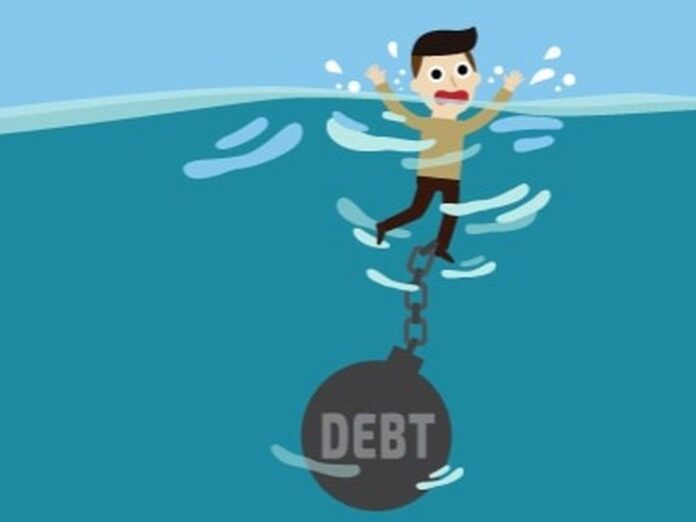Nearly four in 10 Americans struggle to make ends meet every month. Perhaps you can relate.
Whether you’re underemployed, unemployed, or struggling to keep up with the rising cost of living, you might find that a small debt load can quickly become a sizable one.
Drowning in debt can damage your financial, mental, and physical health. So, recognizing the problem and doing something about it is essential to get on the right track.
Continue reading to see nine things you must do to get out of the debt quicksand and find relief.
1. Pay More Than the Minimum Amount

If you’re drowning in credit card debt, one way to slowly claw your way out is by paying more than the minimum due.
Paying only the minimum means you’ll continue to fall behind on your credit card debt every month since the minimum amount won’t chip away at the principal balance. You’ll be like a hamster on a wheel — with the wheel turning slower and slower.
2. Tighten Your Belt Until it Hurts
It’s no surprise that you should spend less than you make. You need to tighten your belt until it hurts if you want a chance to climb out of debt rather than sinking deeper into it. Self-denial is difficult, but that’s the intestinal fortitude you’ll need to sort out your debt problem.
If you like to eat out a few days a week or love shopping on your favorite online e-commerce platform, cut back or eliminate discretionary spending altogether. It’s hard to justify spending money on non-essentials when your financial well-being is damaged.
3. Pay Off Loans With Highest Interest Rates First

While you’ll need to focus on all the debt, you should pay particular attention to the debts subject to the highest interest rates. So, pay off more than the minimum amounts on high-interest debts.
For the other debts, pay the minimum until you’ve cleared the high-interest debt. Another option is to focus on paying off the smallest debts first. As you cross them off your list, you’ll gain more momentum and eventually slay the debt monster.
4. Downsize Where You Can
If you’re deep in debt and need to come up with money to slash debt quickly, consider how you can downsize. One way to downsize is to sell your home and get something smaller or less expensive. That’s a drastic move, but severe debt problems demand drastic measures.
Another way to potentially generate funds to reduce your debt load is to downsize your fleet. Do you have multiple vehicles? If so, are all of them necessary?
In some cases, they might be. But there may be cases where you don’t need a daily driver for work and another more fun car to cruise in on the weekends. Selling one might be a good idea.
Is your debt problem because of a car loan? According to one source, the average monthly payment for a new and used car is, respectively, $726 and $533 per month. That’s the average amount — it could easily be more depending on the car and trim level you choose.
Vehicles are depreciating assets, so it’s foolhardy to continue paying more than you can afford while struggling to stay afloat. You may need to trim the fat and buy what you can afford.
Take inventory of what you have, what you need, and what you don’t need before making some hard decisions about how to get rid of the excess, generate some money, and pay off more debt.
5. Get a Side Hustle

Approximately four in 10 Americans work a side hustle alongside their full-time job. So, if you’re drowning in debt, the answer might be finding another way to generate more income. You can also pick up more shifts at work, apply for a better-paying position, or request a raise. By bringing in more money, you can quickly tackle your debt and get back on track.
6. Track Your Spending
Are you tracking your spending? If so, great. But if you aren’t, start doing so immediately. There are apps for that, so it doesn’t have to be hard.
Even so, tracking where your money is going will help you cut back where you need to. You’ll see your spending habits, find what types of things you tend to buy, and know what things you need to change to see the right results.
7. Save Money on Groceries
Instead of going to the grocery store several times weekly and racking up a ton of money, try doing all your groceries once or twice a month with a written grocery list. Buying in bulk could save you money versus going to the grocery store multiple times a week without a shopping list.
You can also take advantage of sales that get you want for big discounts. Changing where you shop for groceries is another way to potentially save a lot of money on food.
8. Start Budgeting — But Be Realistic

One source says that almost three-quarters of Americans budget every month. You should be budgeting regardless of your financial situation.
But it’s especially vital for people who are struggling financially. Budgeting makes a lot of sense since you can succeed. But when creating a budget, be realistic. If you’re not, sticking with it might be impossible.
9. Get the Help You Need
Another option is speaking to a loan consolidation specialist to see if you can get your situation worked out.
But if that option doesn’t look promising, you might need a lawyer’s help. A bankruptcy lawyer, for instance, can work with you to assess your options. The legal professional can help you decide whether or not to file for bankruptcy.
Bankruptcy relief can help you get some breathing room to rebuild a stronger financial foundation. Rather than being the end of the world, a bankruptcy filing can be the means toward a brighter future. It’s not the only option, but it might be the best, depending on your situation.







